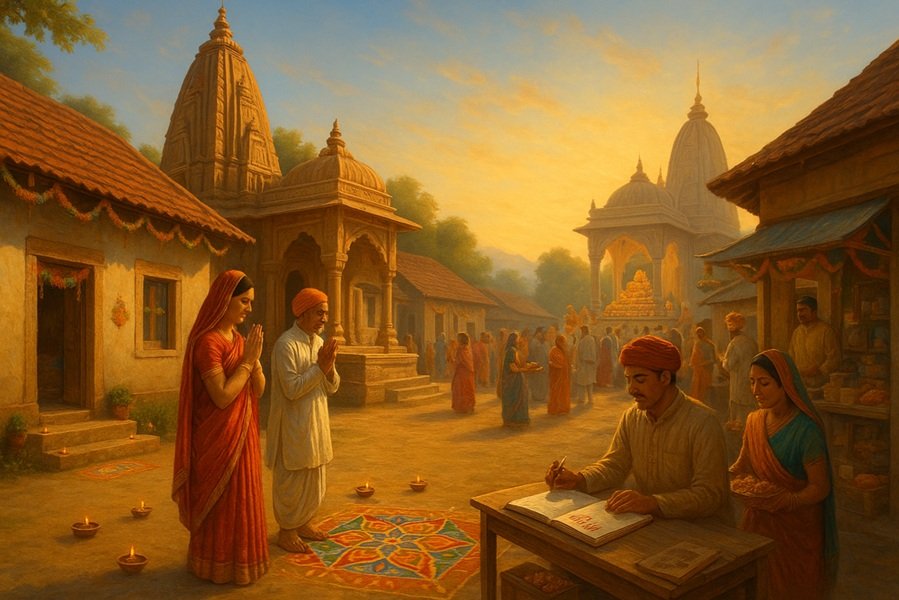
Understanding the Unique Celebration and Cultural Significance of the Gujarati New Year
As the rest of the country celebrates Diwali with fireworks, lights, and festivities, the people of Gujarat prepare for an equally significant and spiritually rich event that follows immediately after Diwali — the Gujarati New Year, also known as Bestu Varas. In 2025, this important day falls on Wednesday, October 22, marking the beginning of Vikram Samvat 2082, the traditional Hindu calendar year observed in Gujarat.
While most regions in India celebrate the beginning of a new year during Chaitra month’s Shukla Paksha Pratipada — known as Gudi Padwa in Maharashtra and Ugadi in Andhra Pradesh and Karnataka — Gujarat follows a distinct tradition. Here, the New Year commences on Shukla Paksha Pratipada of the Kartik month, making it a unique aspect of Gujarati cultural identity.
Let us explore in detail the religious, cultural, and financial significance of the Gujarati New Year, its connection with Govardhan Puja, and the importance of rituals like Chopda Pujan.
Vikram Samvat 2082: A Historical Calendar
The Vikram Samvat calendar, believed to have been started by the legendary King Vikramaditya of Ujjain, is a lunisolar calendar that has been used for centuries across various parts of India. According to this system, the year 2082 will begin on October 22, 2025, in Gujarat, a day after Diwali — one of the most important festivals in Hindu tradition.
Unlike the Gregorian calendar, which begins in January, the Hindu calendar’s start varies depending on the regional and religious customs. In Gujarat, the new year begins after Diwali and is widely celebrated with religious fervor and joyous festivities.
Why Does the Gujarati New Year Start in Kartik?
While many Indian states observe the new year in Chaitra month, the Gujarati calendar uniquely begins its count from the first day of Kartik Shukla Paksha — the day after Diwali. This is rooted in ancient religious traditions and astrological calculations based on the lunar cycle.
The Shukla Paksha Pratipada of Kartik month marks a symbolic renewal of time and prosperity. According to Hindu beliefs, this day is considered highly auspicious, as it signifies the beginning of a new lunar cycle with positive celestial alignments.
Connection with Govardhan Puja and Annakut
Most often, the Gujarati New Year coincides with Govardhan Puja, which falls on the same day as Annakut — a festival celebrated by offering a grand variety of food to Lord Krishna. In many temples, especially those belonging to the Vaishnav tradition like Swaminarayan temples and ISKCON, devotees prepare elaborate displays of food, called Annakut, as a symbol of gratitude and abundance.
Govardhan Puja commemorates the lifting of Mount Govardhan by Lord Krishna to protect the villagers of Vrindavan from the wrath of Indra, the rain god. This mythological event signifies the power of faith and humility, themes that resonate deeply in the spirit of the New Year celebrations.
Thus, the Gujarati New Year is not only a time for personal and familial joy but also an expression of deep spiritual devotion.
Bestu Varas: The Cultural Essence of Gujarati New Year
In Gujarat, the New Year is known as Bestu Varas, a phrase that roughly translates to “the year that has passed.” Paradoxically, it refers to the new year beginning — emphasizing the cyclical nature of time in Hindu philosophy.
Key Traditions and Customs:
- Early Morning Temple Visits: Devotees rise early, take a purifying bath, wear new clothes, and visit temples to offer prayers. Popular temples like Dwarkadhish Temple, Ambaji, and Swaminarayan Mandirs witness huge gatherings.
- Mangal Aarti and Bhajans: Special aartis and devotional songs are performed, often accompanied by the chanting of mantras and shlokas.
- Decorations and Festivity: Homes are decorated with rangoli, torans, and diyas. The vibrant atmosphere carries over from Diwali into the New Year.
- Gifts and Sweets: People exchange greetings, sweets, and good wishes with family, friends, and neighbors. Dishes like ghughra, chakri, sev, and mohanthal are commonly shared.
- Bhai Bij (Bhai Dooj): The second day after Diwali, immediately following Bestu Varas, celebrates the sibling bond — adding emotional and familial depth to the New Year period.
Chopda Pujan: A Sacred Business Tradition
Perhaps the most distinctive aspect of the Gujarati New Year is its deep connection to commerce and business. Gujarat, being a historically mercantile state, integrates spiritual practices into its economic culture. This is most evident in the ritual of Chopda Pujan.
What is Chopda Pujan?
Chopda means “account book” in Gujarati. On Diwali night, businessmen perform a special puja to Goddess Lakshmi (the deity of wealth and prosperity) to inaugurate new account books for the financial year. This marks a fresh beginning in business operations.
During Chopda Pujan:
- Old financial records are respectfully closed.
- New Chopdas (or digital equivalents in modern times) are opened.
- Sacred symbols like Shubh (auspicious) and Labh (profit), as well as swastikas and “Om”, are drawn using vermillion and turmeric.
- Prayers are offered to Goddess Lakshmi, Lord Ganesha, and Saraswati to seek blessings for wisdom, prosperity, and success in the coming year.
This ritual is not limited to big corporations; even small shopkeepers and home-run businesses observe Chopda Pujan with equal devotion and seriousness.
Gujarati New Year: A Harmonious Blend of Spirituality and Commerce
The Gujarati New Year is a beautiful convergence of faith, family, festivity, and finance. It exemplifies how religion and daily life coexist in Indian culture. The day is not only about celebrations but also about reflection, gratitude, and preparing for the year ahead with a clear mind and pure heart.
Unlike the raucous celebrations of New Year’s Eve in the Western world, Bestu Varas is marked by prayer, introspection, and the symbolic act of beginning anew — whether it’s a spiritual journey, a personal resolution, or a business venture.
Final Thoughts
As Vikram Samvat 2082 begins on Wednesday, October 22, 2025, the Gujarati community will embrace the New Year with traditions that have been passed down for generations — rituals like Annakut, Govardhan Puja, temple visits, and Chopda Pujan continue to shape the cultural fabric of the region.
This celebration is not just a date on the calendar but a reminder of the timeless values of dharma (righteousness), artha (prosperity), and samskara (culture) that continue to guide millions of lives.
May the New Year bring peace, prosperity, and happiness to all.
Saal Mubarak! 🌺




